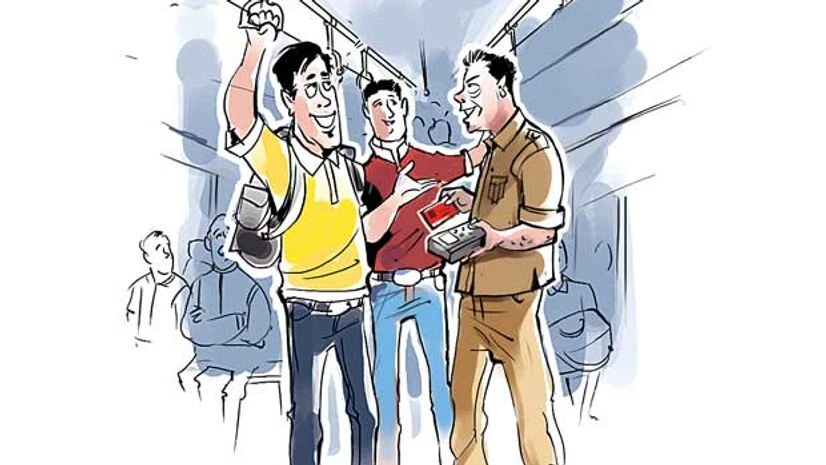Come January 2016, commuters on buses here can pay fares of as low as Rs 6, using bank-issued prepaid cards instead of cash, with the Bangalore Metropolitan Transport Corporation (BMTC) seeking to improve commuter amenities.
BMTC's efforts, aimed at bringing electronic payments into people's daily lives, are part of a larger technology shift in Indian banking.
Other instances include kirana stores affiliated to Novopay, the payment start-up funded by Silicon Valley investor Vinod Khosla. At these stores, customers can pay digitally for groceries and vegetables or get cash in hand after authenticating with an Aadhaar-based biometric system at the stores.
Ezetap, a smart device-based mobile application, makes it easier for merchants such as Amazon to collect money from customers.
In India, millions already use mobile wallets such as Paytm, Freecharge and Mobikwik to recharge phones, buy goods from chosen vendors and pay for cab services such as those offered by Uber. State Bank of India (SBI), HDFC Bank and ICICI Bank, as well mobile operators such as Airtel and Vodafone, also have their own wallets.
The Pradhan Mantri Jan Dhan Yojana has added 185.4 million bank accounts, enabling people to receive government subsidies directly into their accounts. Each of these accountholders also has a RuPay card to withdraw cash from ATMs or pay for groceries.
By the year-end, when the unified payment interface, a technology standard to allow different wallets to connect with each other, goes online, users across the country can transfer or receive money at any time.
A combination of factors, aided by technology, is helping India leapfrog traditional banking models used in the West for cashless transactions. Mobile is the key platform for users, with Aadhaar authentication driving a massive shift. The Reserve Bank of India (RBI)'s move to allow 21 more licences for small banks and payments banks is also likely to bring a massive change to banking in India.
"It is a unique moment for India. Many things are happening - a technology change, regulatory change, government push, Jan Dhan, Aadhaar - and the shift is happening as we speak," says Nandan Nilekani, founder of Infosys and former chairman of the Unique Identification Authority of India. He terms the change underway the "WhatsApp moment" in the Indian financial system. "Technology will allow us to scale to a billion banking accounts."
Data help capture this banking shift. In four years, the immediate payment service (IMPS), which allows money transfer to individuals on their mobiles, online, or ATMs, has overtaken the number of transactions through postal money orders. In July this year, the number of inter-bank IMPS transactions stood at 15.6 million, against 4.26 million in July last year.
Through the past few years, cheque clearances have fallen five-seven per cent a year to 1.1 billion a year, while digital transactions have been growing 40 per cent a year, according to the National Payments Corporation of India (NPCI).
"We have seen a lot of innovations in Silicon Valley. Similar and more innovations are happening in India right now," says A P Hota, managing director and chief executive of NPCI. "Consider Apple Pay; it can only be used with Apple products. Our Aadhaar-based payment transfer is equally powerful. And, it is in an open ecosystem."
Banks, both public and private, are investing in technology to reach out to customers across the country. As the sector grows, the number of branches will increase and there'll be a shift to more technology-focused and less people-intensive branches.
"In the West, people are decreasing the number of branches. Here, we are adding more branches and ATMs. But at SBI, we are looking at more self-service touch points such as ATMs, deposits and video conference for enquiries. There will be minimal staff at each of these branches," says Shiv Kumar Bhasin, chief technology officer, SBI.
"Core needs are fundamentally moving money. Remittances are the first, then savings, credit and insurance. Some of these can be better managed through technology, while some need more face-to-face interactions," says Shikha Sharma, managing director and chief executive of Axis Bank. "But purely, as far as payments and simple savings products are concerned, these are possible using technology."
"Technology is both a disruptor and an enabler, and banks will have to leverage it to their advantage," RBI Deputy Governor S S Mundra had said on October 6. "The impact of disruptive technology is already evident in the form of competition from non-banks such as e-commerce companies, P2P lenders and crowd-funding, which is likely to intensify going forward."
(With inputs from Bibhu Ranjan Mishra and Raghu Krishnan)

)
